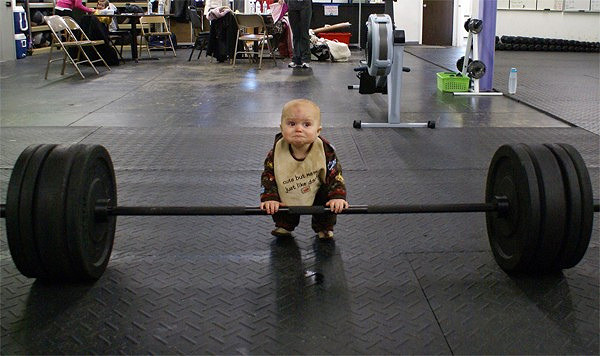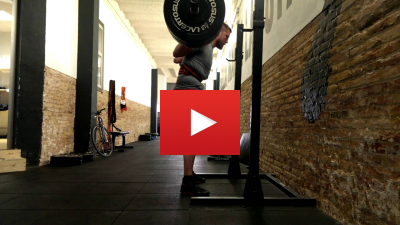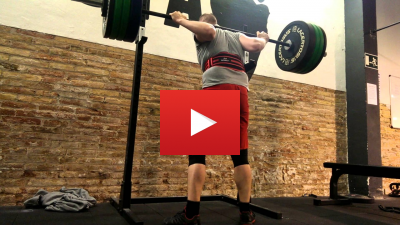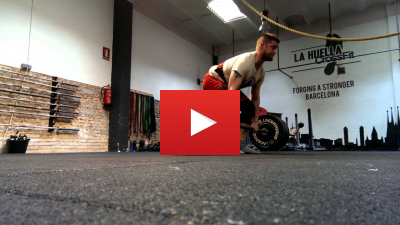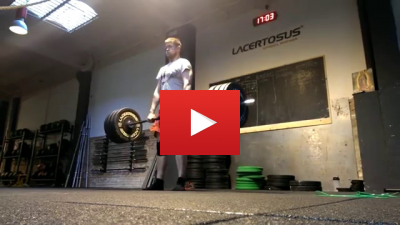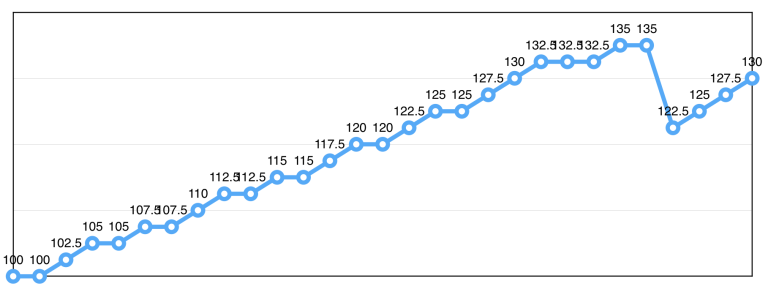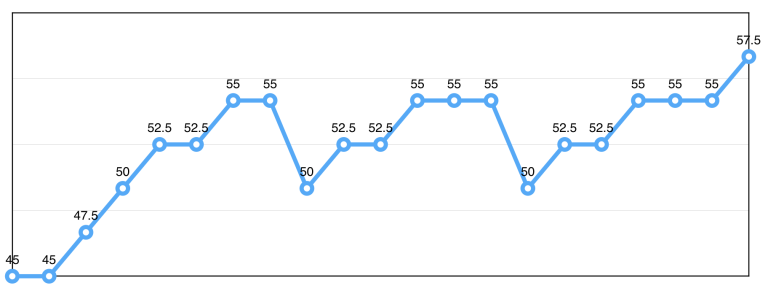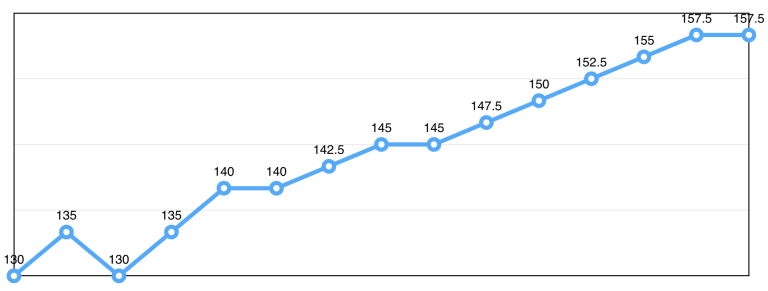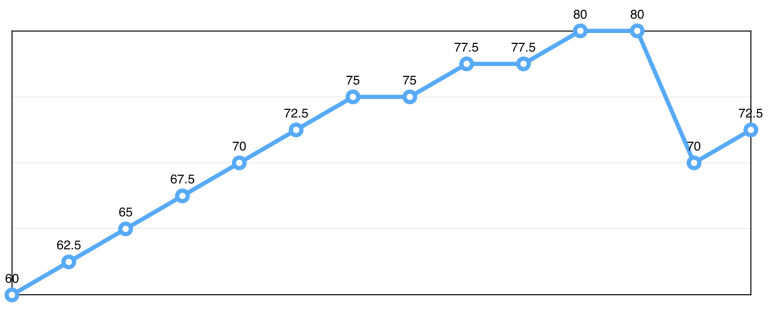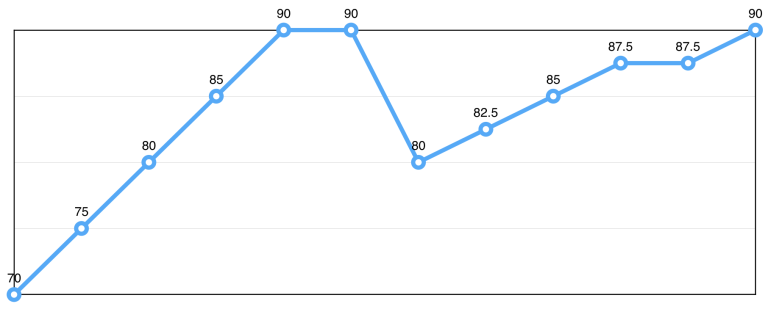Starting Strength is one of, if not the, most popular strength training programs out there. If you want to grow strong, stop looking for a better program – there isn’t one. Here’s how to use it.
Starting Strength is not only a training system but a book as well, both by Mark Rippetoe. When I say Starting Strength in this article I’m referring to the training system. More on the book later.
Table of contents #
As the name suggests, Starting Strength is aimed at beginners. When you’re just starting out you have a unique potential to grow strong like you will never experience again in your strength career.
We call this the newbie gains (sorry, gainz).
Take note though! Just because you’ve already spent years in the gym, doesn’t mean you’re not still a beginner when it comes to strength training. The creator of Starting Strength, Mark Rippetoe, says:
“You can take the average guy who for 10 years has fucked around in front of the dumbbell rack and walked on the treadmill watching TV. You can take that guy and get him to adapt and grow. First thing you do is get him to squat. And two days later, you can get him squatting again, but five or ten pounds heavier. Whether he’s 25 or 35 or 55, if that adaptation hasn’t occurred, it still can occur. Most people out there, despite what they think, are still beginners.”
– Mark Rippetoe
, by [Jason Kelly](https://www.linkedin.com/in/jason-kelly-cpt-cscs-80a856112). Deadlift muscles](http://images.ctfassets.net/nnuq76eqamrs/rYbEMKUOk8qWR2zU4MNnX/e6f9c7a7b00048a7834bc3910e397393/deadlift-muscles.png)
Starting Strength is entirely based on barbell training, because the barbell is unique in how well it can be progressively loaded and used safely with increasing weight.
There are of course a lot of equipment one can use to grow stronger but using the barbell and the Starting Strength training system is probably the fastest and most efficient way you can find.
Newbie gains #
To grow stronger, you’ll need to lift increasingly heavier weights. This is called progression.
Starting Strength uses something called linear progression, which is the most simple type of progression. Basically you’ll add a little weight every day and over time this grows into a huge amount of weight. It’s very simple and therein lies its beauty.
There’s a famous story about a greek wrestler, back in the 6th century BC – Milo of Croton. He’d train by lifting up and carry around a newborn calf. Every day he continued doing so and as the calf grew into a bull, so did he. This is linear progression.
Of course you can’t keep increasing this forever but you can take it quite far if you keep at it.
Most people seem to be able to grow their strength to where they can bench press their own body weight, squat one and a half times their body weight, and deadlift even more.
When you start to reach these heavier weights, it will get tough. If you haven’t done a proper strength training program before it’ll test you both physically and mentally. Push through and it’ll also reward you plenty!
Structure #
The structure of Starting Strength is super simple, which is a good thing.
Complicated programs are either for very advanced lifters or for personal trainers trying to impress their clients with fancy circus exercises. They’re not for you and me.
To grow strong you just need a few basic exercises that’ll load and train the most amount of muscle, for as long a range of motion as your body allows, using as much weight as possible.
Two workouts #
Following the Starting Strength training system, you’ll alternate between two workouts: A and B.
Workout A
- 3 x 5 Squats
- 3 x 5 Overhead Presses
- 1 x 5 Deadlifts
Workout B
- 3 x 5 Squats
- 3 x 5 Bench Presses
- 1 x 5 Deadlifts
This reads as three sets of five squats and presses, and one set of five deadlifts. That means you’d do five consecutive squats, put the bar down, wait a couple of minutes, and then repeat for two more sets.
The order is important, as the squats are meant to warm your whole body up, the following press lets your legs and back rest before the final pulling movement.
You alternate these workouts three days a week, for example on Monday, Wednesday, and Friday.
Pick any days that are convenient for you but make sure you have at least one day of rest between each day. This might sound like very little training to some but trust me – with this program you absolutely can not skip the rest days.
Two example weeks could look like this:
Week 1
Monday: Squat, Press, Deadlift
Wednesday: Squat, Bench, Deadlift
Friday: Squat, Press, Deadlift
Week 2
Monday: Squat, Bench, Deadlift
Wednesday: Squat, Press, Deadlift
Friday: Squat, Bench, Deadlift
Week 3 starts over with Workout A: Squat, Press, Deadlift. Simply just do one after the other.
Of course, you could pick Tuesday, Thursday, and Saturday for your training days if you wanted to. Or Sunday, Tuesday, and Thursday. As long as you have at least one day in between training days, so your body has time to recover and actually grow stronger.
Four phases #
Because Starting Strength is aimed at beginners, it takes off with only four exercises. The idea is to start light and focus on getting your technique right, before slowly increasing the weight.
It can be tempting to want to blow through these phases as soon as possible but then you’d be doing yourself a disservice. The longer you can stay at each phase and still recover and grow stronger, the better your end results will be.
E.g. some people want to finish the whole Starting Strength training program as soon as possible, so they can call themselves Intermediate lifters. But why would you rush to get to a place where progress is slower? It defeats the purpose. Don’t you want to get as strong as you possibly can?
You’ll find different setups than the one below, all around the Internet. I don’t know which book they’ve been reading but what follows is directly from Starting Strength: Basic Barbell Training, 3rd edition.
Phase 1 #
Workout A: Squat, Press, Deadlift Workout B: Squat, Bench, Deadlift
Take your time in the first time to really grind technique. Treat each lift as if it was properly heavy, even if it’s not. Big breaths, brace properly, squeeze the bar, and learn to work with your whole body.
At this point you should already be reading the book (see below), because it’ll begin teaching you how to safely and effectively perform the lifts, which is one of the main purposes for this phase.
The other purpose is to let your body adjust to squatting and deadlifting thrice a week.
This first phase ends when the freshness of the deadlift has worn off a little and after the initial weight increases have placed the deadlift well ahead of the squat. Normally this takes 2-4 weeks.
Phase 2 #
Workout A: Squat, Press, Deadlift Workout B: Squat, Bench, Power clean
Now that the deadlift is getting too heavy to recover from doing every training day, it’s replaced by the power clean every second day. A similar but more explosive exercise that you can keep growing with.
Keep doing this for another 2-3 weeks, to get somewhat comfortable with the power clean.
Phase 3 #
Workout A: Squat, Press, Deadlift Workout B: Squat, Bench, Power clean, Chin-up
In the third phase you add three sets of chin-ups after the power cleans, to get some more upper body volume (and to build those guns).
When you can do more than 3x10 chin-ups, you start adding weight to it. Add {2.5 kg} at a time, with the goal of being able to do more than five reps but less than seven (at which point you increase).
This third phase continues for a long time; many weeks or months.
As your ability to recover starts becoming pushed to its limit, and you feel like you’re no longer making as good a progress as before, it’s time to try the fourth and last phase of Starting Strength.
Phase 4 #
Workout A: Squat, Press, Deadlift/Power clean Workout B: Squat, Bench, Back extension, Chin-up
In the fourth phase we have Workout A alternate between deadlifts and power cleans, so they’ll each be done every fourth training day. This will help with recovery from these heavy lifts.
In between we’ll do chin-ups and back extensions, using the 3 sets of 5-7 reps described above.
It’ll look like this:
Week 1
Monday: Squat, Press, Deadlift
Wednesday: Squat, Bench, Back extension, Chin-up
Friday: Squat, Press, Power clean
Week 2
Monday: Squat, Bench, Back extension, Chin-up
Wednesday: Squat, Press, Deadlift
Friday: Squat, Bench, Back extension, Chin-up
In this phase you’ll find that you might want to start taking smaller increments on the presses. That’s when micro plates can come in handy, allowing you to add {1 kg} or less at a time.
One final modification is to keep the squats on Wednesdays lighter (80%), to allow for better recovery. That’s pushing the program though and when you get to this point, I think you should consider finishing Starting Strength and going on an Intermediate program.
Five exercises #
The book does an excellent job of explaining the different exercises and how they’re performed.
These five big lifts (squat, deadlift, press, bench press, power clean) were chosen for very specific reasons, to provoke very specific adaptations in your body. If you want to get into powerlifting or some other strength sport, you’ll probably want to tweak that list of exercises but to get as strong as possible, as fast as possible – that’s pretty much all you need and nothing of what you don’t need.
If you’re a visual learning, you might appreciate these introductory videos from Art of Manliness:
Squat
Deadlift
Press
Bench press
Power clean
Progression #
Start with the empty bar. It might feel silly but chewing off more than you can handle is only stupid.
You’ll initially be squatting and deadlifting three times per week, which is probably way more than you’re used to. Every session will use pretty much all the muscles in your body and so you’ll be thankful for the adjustment period.
If you really want to start with heavier weights, because you have some decent experience lifting heavy and often, then you should know your 5RM. Start at 20% less than that.
Once you’ve established your starting point, you’ll start adding weight.
Like I said before, Starting Strength uses linear progression. In this context that means you’ll add weight every training session and thus try to keep even steps with your increasing strength.
Some programs use complex periodization, with high volume days, low intensity weeks, max effort sets, and so on. Starting Strength has none of that – you lift and you add weight.
“I’m not against periodization, I’m against applying periodization to the wrong population. Periodization is a complete waste of time for beginners. My rule is simple: The less adapted you are, the more straight forward the programming.”
- Mark Rippetoe
The lifts improve differently from each other and between lifters. Normally the squat and the deadlift will increase at the same speed, with the deadlift slightly ahead, while the press and the bench will follow each other at a slower pace.
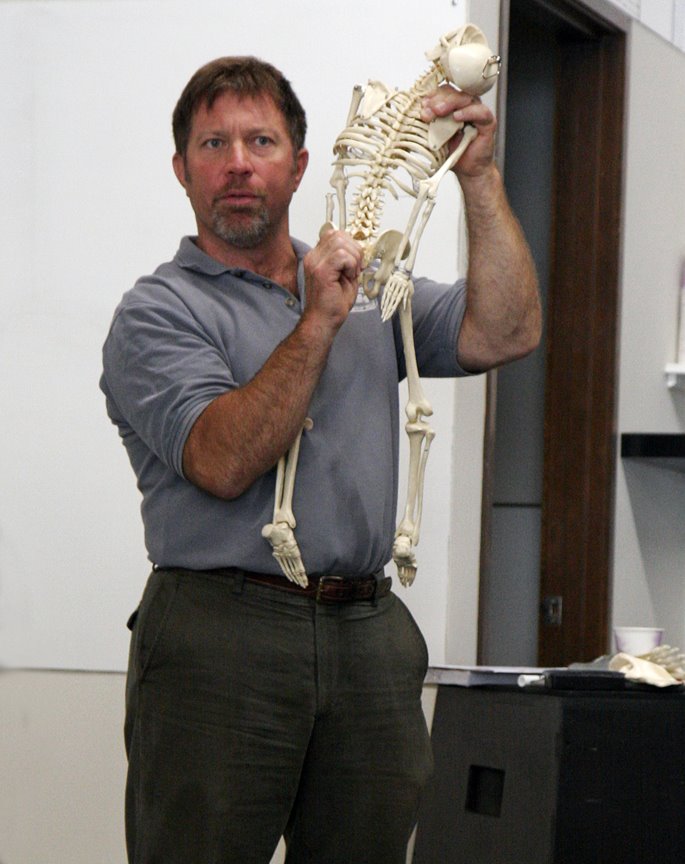
In the beginning you’ll add maybe {10 kg} after each successful squat and deadlift session and {5 kg} after each press and bench. So if you successfully (with good technique) squat three sets of five reps at {60 kg}, then you add weight till next squat session and try at maybe {70 kg}.
If instead you fail the three sets, you try again next time. Unless you fail more than once, in which case it might be time for a deload (see below).
When the weights are getting heavier and you’re struggling to add that much, you’ll start adding less. Squat and deadlift get {5 kg} increases, while the press and bench get {2.5 kg} increases.
Later, even that will become tough and you’ll have to start increasing by {2.5 kg} and {1 kg} respectively.
Yeah, technically it’s not a strict linear progression (k != 1) but you get the point.
Deloading #
Naturally, you can’t keep increasing the weight forever. Eventually the fun stops. Your task is prolong these initial newbie gains for as long as possible – you’ll never make as good progress again.
One method you can use to prolong this process is by deloading.
Most likely one of the lifts will stop progressing before the others.
Your deadlift will be stronger than your squat, which will be stronger than your power clean, followed by the bench, and finally the press.
When one of them stops progressing it’s because of on of four reasons:
You don’t recover well enough. Eat more food, sleep more, take more naps, and try to stress less.
You’re not increasing the way you should. Stop being greedy and pick smaller increments.
You’ve added your own exercises or made other changes to the program.
You’re done with linear progression.
Everyone can have a bad day, with too little sleep, a shitty boss, or crap food. Don’t give up just because you fail a lift every now and then. Sometimes it can take another attempt or two, so keep doing as many reps you can for the remaining sets.
If you fail thrice in a row though, or aren’t making any progress to succeeding with the three sets of five reps, then it’s time to deload. It’s a restart to help you attack the weight a little fresher.
Decrease the weights for that specific exercise by 10% and try again from there, next training session.
If you’ve already tried that but you keep hitting the same weight limit, it can help to deload 10% again but do as many reps as possible at that lower weight, up until you can only do five reps again when the weights come back up.
When that doesn’t work you’re probably done with linear progression, should have some pretty nice weights to show off, and it’s time to move on to an Intermediate program (see below).
Warmup #
Warming up before lifting is important for two reasons: injury prevention and practice.
Please heed the following rather strong statement: if your schedule does not allow time for proper warm-up, it does not allow time for training at all.
- Mark Rippetoe
Warming up actually increases the temperature in your body and this helps prevent injuries. It’s especially important if you already have an injury or if you’re a bit older.

You could warm up using a rower (or a bike or treadmill) to work up a sweat and that’d be advisable if you train in a cold environment. But then you’d miss out on the second benefit of warmups: practicing the lift.
Instead, skip straight to the barbell and warm up with the empty bar. Two sets with just the bar and then make three jumps up to close to your work weight.
Rippetoe makes the following example, if you’re going to squat 5x3 at {100 kg}:
- 2 sets with just the bar ({20 kg})
- 1 set of 5 at {40 kg}
- 1 set of 3 at {60 kg}
- 1 set of 2 at {80 kg}
- Start the workout at {100 kg}
Don’t rush the warmup sets just because they’re light. Treat them as you would a heavy work set and focus on improving your technique. This too is training!
Warming up doesn’t have to be complicated but if you want someone to just tell you what to lift, try the Android or iOS app.
Diet #
Now to a more controversial part of Starting Strength – the diet.
Rippetoe suggests consuming 3500-6000 kcal per day, while on this program. That’s a shitload of calories. Further, he advocates drinking a whole gallon (3.8 liter) of milk per day (GOMAD)!
“It is apparently a persistent tendency, since about 1990, for boys to think they need a “six pack”, although most of them don’t have an ice chest to put it in.”
- Mark Rippetoe
Needless to say, these recommendations have turned a few heads.
However, most of the online critics don’t seem to have actually read the book. After having done so myself, I think the recommendations actually in the book are pretty good for the given audience.
No, not everyone should eat 6000 kcal and not everyone is encouraged to drink that milk.
Rippetoe talks about the different caloric needs of skinny hardgainers and fat people (not used derogatorily). The former could do with eating like it was their job and the latter would aim for the lower 3500 kcal recommendation, mainly from whole food sources.
Vegans on Starting Strength #
Of course, like most carnists in the fitness world, Rippetoe talks exclusively about protein from meat, eggs, and milk. As vegan athletes we know there are loads of great vegan protein sources.
Skinnier vegans should make sure to increase their fat intake and try to drink more of their calories – two effective ways to drive up the total calories. Check out my breakfast, lunch, and dinner recipes!
The book #
Starting Strength: Basic Barbell Training is probably the most cited book when you ask people what the most important strength training book has been for them. It’s a bible in the iron world.
One of the most common mistakes people make when following the Starting Strength training system is to not read the book. With all the online material – like this very guide – it might feel like you don’t need to also read a book.
You’d be mistaken.
The bulk of the book is in fact not about the program, but the exercises. Take the squat for example – Rippetoe spends 65 pages explaining how to sit down and stand back up with a weight.
It’s incredibly detailed and it goes through everything from why to do these specific exercises, to how to set up for the lift, as well as potential mistakes and their fixes.
If you’re planning on lifting weights for some time, you owe it to yourself to read this book. Even if you think you’re doing everything correct, you will learn something new, improve your technique, learn to lift heavier weights, and stay injury free for longer.
My results #
At the end of 2015 I realized that my 1RMs were the same as the beginning of the year. Almost a whole year had gone by and I hadn’t gotten any stronger. That’s a big failure in my book.
So I decided to do a strength program.
A friend of mine had gotten some good results from Starting Strength, so I figured why not? I’d commit to it for at least six months and then see where I was at.
I started with a {121 kg} squat, {80 kg} bench, {60 kg} press, and {140 kg} deadlift.
A few weeks in, the weights had gotten heavy enough that I had to really struggle with them. Then something really cool started happening – I could feel myself growing stronger.
I came in to squat a weight on Monday and almost didn’t make it, but since I finished all sets I increased the weight. On Wednesday I’d feel a little scared about this new weight but lo and behold – I could do it! The following Friday I increased again and now it felt easy.
Quite an impressive feeling.
Squatting {112.5 kg} versus {130 kg}.
Deadlifting {135 kg} versus {150 kg}. See more videos on my YouTube channel.
I did make sure to sleep plenty and I ate pretty much anything I could get my hands on, both of which I feel made a huge difference. As the weight on the bar went up, so did my bathroom scale.
Slowly but surely, over time, I stopped making progress. I tried resetting a couple of times but would end up failing at the same weights again, which is when I decided to pull the plug and consider my strength officially started.
I ran the program for three months before it stopped working for me. This is likely due to me having done some strength training before, because I know others have been able to push Starting Strength for much longer than that.
I went from {86.4 kg} when starting out, to {92.3 kg} in the end and these were my lifts:
Squat #
Went from {121 kg} for one repetition, to five reps at {135 kg}.
Press #
Went from {60 kg} for one repetition, to five reps at {55 kg}.
Deadlift #
Went from {150 kg} for one repetition, to five reps at {157.5 kg}.
Bench #
Went from {80 kg} for one repetition, to five reps at {77.5 kg}.
Power clean #
I don’t know my max from before but I ended with three reps at {90 kg}.
All in all a {62.5 kg} (18%) increase for my powerlifting total (squat, bench, deadlift). Not too shabby!
The squat and deadlift increased the most, as was predicted, because they involve the most muscle mass and thus have the best growth potential. This led to a newfound love of the squat for me.
I’ve since learned that I react much better to a higher volume for the press exercises. It’s not nearly enough in Starting Strength but I wonder if it would even be possible to recover if that increased.
Common questions #
Should I do Starting Strength? #
Probably, yes. If you’re deadlifting less than double your body weight – give it a try!
What happens if I miss a workout? #
It’s a rolling program, so you simply do the missed workout the following training session.
Can I add X or remove Y? #
The program is the program and if you don’t follow it you’re Not Doing The Program™. Every repetition in the program is there for a reason and every repetition not in the program is omitted for a reason.
If you’re used to train harder it might feel weird to leave the gym feeling like you could have done a couple of more sets, or at least thrown in some biceps curls. But ask yourself – how has that worked for you so far? Has it led to the same kind of progress that people get from Starting Strength?
You don’t have to feel like you’re close to dying, drowning in your own sweat, just for a workout to be effective. A much better indication that you’re making progress is that you’re constantly feeling tired and hungry, no matter how much you sleep and eat.
If you have to make changes, at least read the book to understand the reasoning behind the program.
Can I train four days a week? #
Strength training is about more than just lifting weights. Recovery is a very important part and if you don’t eat properly, sleep plenty, and follow the program’s rest days, you’re Not Doing The Program™.
Expect results thereafter.
What equipment will I need? #
A barbell, weights, a rack, and a bench.
It’s also helpful to have a lifting belt, micro plates, weightlifting shoes, and chalk.
Can I do Starting Strength and X? #
Probably not. The incredible progress of Starting Strength makes it a pretty exclusive program, so it’s not advised you do much other strenuous activity on the side.
What should I do after Starting Strength? #
Then you start an intermediate program, like the Texas Method, Madcow, or 5/3/1.
How long should I rest between sets? #
Rest as long as you need to be able to succeed with the next set.
This could be 2-3 minutes in the beginning, up to 5 later on, and around 8 minutes towards the end.
My take-aways #
Training is like sun tanning. You have to spend time in the sun and then let your body heal up, for it to bronze. If you spend too much time, you’ll burn, but you have to keep pushing it to become gradually browner.
Base your training on the four big lifts – they are simple to learn, hit every muscle in your body, and strike a great balance between allowing you to lift a lot of weight, while performing as full a range of motion as possible. No need to complicate things.
Recovery is key to growing big and strong. I knew this but now I’ve also experienced it. Going from training six days a week to only three allowed me to grow stronger than I’d ever been before.
The Starting Strength forum is a great community and resource to learn from.
In summary: Starting Strength works and it works damn well. I’ve never progressed as fast before and I’m far from the only one. If you want to grow strong – commit to and try it out!
If you use the links above to buy the Starting Strength book, I get a small commission and it doesn’t cost you anything extra. It’s an easy (and free!) way to support Athlegan.
I’d like to thank the giants at Starting Strength, coach Rippetoe in particular, on whose shoulders this guide stands; just scratching the surface of the wealth of knowledge provided by The Aasgaard Company. Their massive and ongoing contribution to the strength and conditioning world have been invaluable to the many thousands helped by it, myself included.


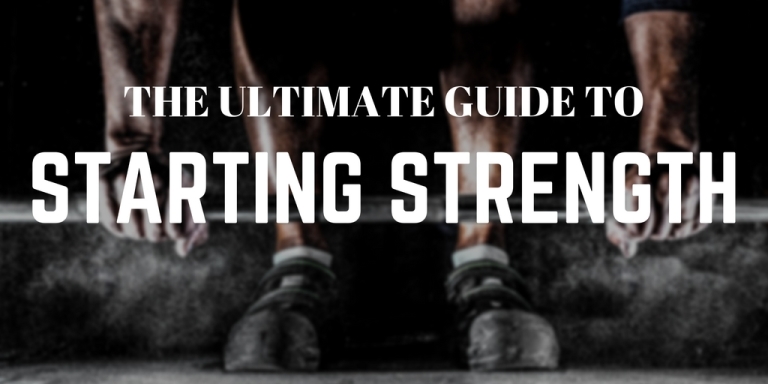

, by [Jason Kelly](https://www.linkedin.com/in/jason-kelly-cpt-cscs-80a856112). Overhead press center of mass](http://images.ctfassets.net/nnuq76eqamrs/2VQQ2SAhTX4OfvW7rTsrfS/3efe8ddb9831e0f01035049e360dca98/overhead-press-center-of-mass.png?w=768&q=100)
